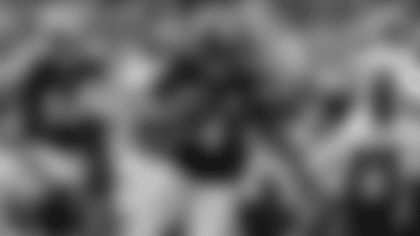Life has a funny way of leading us to where we belong.
And so it was for Steelers head athletic trainer John Norwig.
Norwig, the Steelers' head trainer since 1991, has officially announced his retirement, ending a long and successful career with the team.
"It's pretty hard to sum it up in just a few words what John has meant to us for 32 years," said Steelers president Art Rooney II. "He's been a consummate professional. And just on a personal level, he's had relationships with so many people. He handled himself the way you would hope everyone on the staff conducts himself. He's as good as it gets in terms of somebody that comes and stays for 32 years and provides us with that level of professionalism. I think our medical staff has been the best in the NFL for a long time, and he's part of the reason for that for sure. We're going to miss him."
As fruitful and successful as he's been as a trainer, Norwig didn't set out to become one when he enrolled in college. The profession found him. And it became more than a profession. It became his life's work.
"In 1977, I was a sophomore in college, I had an academic advisor at a branch campus of Penn State. I played basketball at Penn State-York. It was a new major at Penn State," said Norwig, 65. "He said based on your interests, you might want to look at this. When I transferred to University Park that spring, I met with the curriculum director, and I really didn't know what I wanted to do. Thank God he was a nice guy. He took a shine to me. I got into the major and the rest is history.
"I didn't know much about it, but I came to find out it involved being in athletics. I enjoyed sports. I grew up around them. My father was a big sports fan. Also, the healthcare part of it was of interest to me. As I got more and more involved as a student, it became my passion."
Little did Norwig know his passion would lead him to the NFL.
In fact, had anyone told 20-year-old Norwig that 40 years later he would be completing more than three decades in the NFL, he might have thought them a little crazy.
That's not where Norwig saw his career path.
"I grew up in central Pennsylvania, Hanover Pennsylvania. I was at a small high school, so you get to play all the sports," Norwig said. "You just go out. Nobody gets cut, except for basketball. Athletics and sports were in my blood. I had a love for sports. I knew as an athletic trainer, the most demanding and most challenging sport was a contact sport, football. If you were going to be an athletic trainer and really loved being an athletic trainer, you wanted to work football. I thought coming out of college, I would work at a small college and maybe have the opportunity to teach. But my life took a different turn."
Again, it was a simple twist of fate and taking advantage of an opportunity when it presented itself.
After completing his undergraduate degree at Penn State, Norwig accepted a position at nearby Bellefonte High School. But he kept in touch with the people at Penn State as he continued to work on his Master's Degree in Health Education.
"This was before they had graduate assistantships. The position of men's basketball trainer opened up while I was at Bellefonte High School, and no one at the university wanted to work with the coach, who was a bit of a tough guy. He was difficult to work with. I had worked with him as a student, and I had a good relationship with the head trainer at Penn State. I said, 'If nobody wants to do it here, why don't you give me the opportunity?' Luckily, I had a good relationship with the guy and he agreed.
"It was challenging. I was young. I was 21, 22 years old. It was a great break for me. It was a huge opportunity."
But opportunities are only what you make of them. And Norwig was intent on making the most of the ones afforded him.
While at Penn State, some of his students approached him and asked him what it was like to work in the NFL?
Norwig had no reference points from which to inform them, so he decided to be better able to inform them, he would call on a former classmate at Penn State who happened to work for the San Francisco 49ers.
"I gave him a call and said, 'Hey, can I come out to training camp and see what it's like?' He gave me the opportunity to come out, and that opened a lot of doors for me," Norwig said. "Even though I filled the water coolers full of ice, I was a certified athletic trainer. I was doing what a student would do. I really enjoyed it. It was a great experience. And I got to network with some other people there. The head athletic director for the 49ers was a guy named Lindsy McLean, and Lindsy was a Vanderbilt alum."
That would prove to be important when, a year later, Norwig received a call out of the blue. Vanderbilt was in the market for a head athletic trainer. And Norwig had been recommended.
"I didn't apply for the job, but the athletic director at Vanderbilt called and asked if I would be interested in interviewing," Norwig said. "Back then, there was no internet. I had to get what they called the Blue Book and look up where Vanderbilt was. I didn't realize it was in the Southeastern Conference with Georgia and LSU and Florida and Kentucky. We were the doormat of the Southeastern Conference, but man, what a great opportunity. I was 27 years old. It was a big deal to me professionally."
Indeed. Norwig was on the move to Nashville, Tenn.
It wasn't a big staff, just Norwig and a couple of other trainers at first. But it meant more exposure to a different part of the country and new people, including his wife, Emily, whom he met while in Nashville.
Because of the hours Norwig and his staff put in – especially during the season – Emily Norwig might be considered his chief of staff.
"Her dad was deputy sports editor for the Nashville Tennessean. She realized what she was getting into. She's a big sports fan and she knew her dad wasn't home very much," Norwig said. "We have two boys and a girl. She did a lot of that rearing of those children. She was, and still is, my biggest ally. You take this home. When you win, everything's good. When you lose, everything's not so good. You're not supposed to, but that still goes home with you."
As the head trainer at Vanderbilt, Norwig was responsible for not just the staff, but interacting with NFL teams when they contacted the program about medical issues involving potential draft picks.
In 1991, that led to a call from Tom Donahoe with the Steelers.
Norwig took the call and immediately began to reach for his medical records on the team's draft prospects.
Donahoe had something else in mind.
"I thought he was going to talk to me about our seniors. He said, 'No, I want to talk to you about coming up here and interviewing for a potential position,'" Norwig said. "I didn't know the position was open. But I do know Tom was friends with a guy named Tim Kerin, who was the head athletic trainer at Tennessee. He was at Pitt before that, and they went to school together at IUP.
"Tim never told me this, Tim is deceased now, but I'm 99 percent sure Tim said to take a look at the guy from Vanderbilt. Tim was my ally, my friend in the Southeastern Conference. I was the youngest head athletic trainer in the Southeastern Conference. Tim knew I went to Penn State and really extended a welcome to me and made me feel comfortable. He was really a guy I could bounce things off of. I'm sure that's how Tom Donahoe found out about me."
He flew to Pittsburgh and met with Donahoe and Dr. Tony Yates, the team's head physician at the time.
That interview took place prior to the draft. After a month, Norwig hadn't heard back from the Steelers to be offered the position – or to let him know someone else had been offered.
"I called Tom Donahoe and I asked if they had made any decisions yet?" Norwig recalled. "He said, 'No, we haven't hired anybody yet.' I said, 'I'm here at Vanderbilt and if I'm going have the opportunity, I'd have to sell the house. I'd have to move my wife. I'd like to get to know the players with the Steelers. Can you guys give me an idea of what you're going to do?'
"Forty-eight hours after that, I got a call, 'Why don't you come up and interview for the second time?' That's when I met with Mr. (Dan) Rooney, Tom Donahoe and Tony Yates again, and that's when I got offered the position. In less than a week, I was back here living in the Allegheny Center."
Norwig has been with the Steelers since, traversing the tenures of the end of the Chuck Noll era, the entire Bill Cowher era and, finally, the past 16 years with Mike Tomlin as the team's head coach.
There have been plenty of AFC Championship games, both wins and losses, and four Super Bowls, with two wins and two losses, as well.
Norwig doesn't take any of that for granted.
"There are peers who have done it as long or nearly as long as I have and have never been to a Super Bowl," Norwig said. "So, I'm thankful for that."
And he's thankful for all of the help he's had along the way and the medical staff with which he's worked closely.
"I don't think this profession looks for credit. But one of the reasons we've been as effective as we've been is because of the people that are around, not only the assistant athletic trainers, but we have had a network of physicians that have been outstanding," Norwig said. "(Dr.) Jim Bradley has been with us for three decades. (Drs.) Tony Yates, Joe Maroon, our neurosurgeon, and the guys that have replaced them, Aaron Mares and David Onkonkwo, our neurosurgeon, that's the core of people that work. We have literally dozens of physicians within the UPMC system that are consultants, great people.
"I don't think you can do this, pour your heart and soul into the job, and not want to win. I root for our players. You develop a relationship with these folks. Even though most of the players are here for two or three – very few of the players are here for 10 years – you develop a relationship with them. I've had a lot of good ones with many great athletes."
And the trainers he's worked with over the years. Some, such as Rick Burkholder in Kansas City, have gone on to run their own NFL staffs. Others have been groundbreaking hires.
In 2002, Norwig hired Ariko Iso, now the head football athletic trainer at Towson State, as an assistant trainer for the Steelers. She was the first full-time female trainer in the NFL.
"I can't take all the credit for that," Norwig said modestly. "Bill Cowher was the head coach, and Dan Rooney was (in charge). We thought we wanted to hire the best person and that happened to be a female.
"I did go talk to Mr. Rooney. I talked to Bill Cowher. And I talked to some of our players before that decision was made. Mr. Rooney was, 'Hey, if you think she's the best person, get her hired.' Bill Cowher said, 'Hey, I have three daughters, if I tell you that you can't hire a female, how am I going to go home tonight?' The players, Ariko had worked here for two summers, so the players knew her. They knew how hard she worked and what kind of person she was. She was a good fit."
That has been one of just many changes that have happened in the profession over the years. In his more than four decades, Norwig has seen his profession grow from being the people who filled the water coolers, taped up players and helped them with their rehab and stretching, to what it is now with training pools and body pods and all of the other instruments that help keep players running at their optimum.
"When you talk about over three decades, what's happened in sports medicine, the technology has changed so much, imaging, science has changed," Norwig said. "We can diagnose injuries so much better. When I say we, I mean our physicians. The MRI, when I started, it was not nearly used as much as it is today. One of the real new things in the past 10 years is musculoskeletal ultrasound.
"We now have a physician here, Aaron Mares, who is an expert in that. He's made us better. Other things like staff sizes, equipment, surgical technique, rehabilitative technique, all that stuff has changed. That's why it's imperative to continue to educate ourselves. Recovery is huge now. Recovery when I first started was going to (a bar) for a beer. There's sleep. There's hydration. There's nutrition. The NFL has changed a lot, and it's changed a lot to protect the investment, the players. I think we're doing a much better job of that than we did three decades ago."
Norwig has been at the forefront of that change for the Steelers.
When he started with the team in 1991, the training room was just that – a small room. Now, he has an entire bustling area at the UPMC Rooney Sports Complex.
And even so, sometimes that's not even enough.
But when you spend so much time at your job, you learn and you continue to get better at it.
"I think we hire people here who have the personality to handle adversity, that have camaraderie, that are a team," Norwig said. "I think that the people we hire here are very well educated. And I think they continue to educate themselves and make themselves better. That's what we have to strive for.
"As an athletic training room, things change. Gosh, they've changed a lot over 30 years. One thing that has been constant here, is not only our athletic trainers, but our medical staff has continued to want to get better and try to stay current. We're not perfect, but I think we're pretty good."














